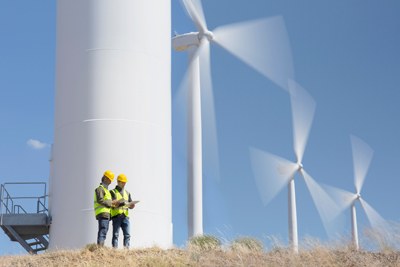White Paper: Global Wind Farm Market Trends, Revenue Models, and Future Outlook
Executive Summary
The global wind farm market is experiencing robust growth, driven by increasing demand for renewable energy, supportive government policies, and technological advancements. Valued at approximately USD 97.05 billion in 2024, the market is projected to grow at a compound annual growth rate (CAGR) of 4.9% from 2025 to 2030, reaching USD 141.09 billion by 2030. Offshore wind farms are expected to lead this expansion due to higher efficiency and the ability to leverage stronger winds in deeper waters. This white paper explores key market trends, revenue models, and the future outlook for wind farms, providing insights for stakeholders, investors, and policymakers.
Market Trends
1.1 Rising Demand for Renewable Energy
Global efforts to combat climate change and achieve net-zero emissions are accelerating the adoption of wind energy. Governments worldwide are implementing stringent environmental regulations and offering incentives to reduce reliance on fossil fuels. For instance, the European Union’s Green Deal and the U.S. Inflation Reduction Act (2022) are driving significant investments in wind energy projects. In 2023, wind energy generated over 2,330 TWh globally, with China contributing nearly 60% of the growth.
1.2 Growth in Offshore Wind
Offshore wind farms are gaining traction due to their higher capacity factors (0.5–0.7 compared to 0.25–0.3 for onshore) and access to stronger, more consistent winds. The global offshore wind market was valued at USD 55.9 billion in 2024 and is projected to grow at a CAGR of 14.6% through 2034, reaching USD 298.8 billion. Europe leads with over 2 GW of offshore wind turbine orders in the first half of 2024, while Asia Pacific accounts for nearly 50% of global wind installations. Innovations like floating wind turbines, such as the Kincardine project in Scotland, are expanding viable sites to deeper waters.

1.3 Technological Advancements
Advancements in turbine technology are reducing costs and improving efficiency. Larger rotor diameters, taller hub heights, and higher-capacity turbines (e.g., >3 MW) are becoming standard. For example, CSSC Haizhuang’s 18 MW offshore turbine with a 260-meter rotor, introduced in 2023, exemplifies this trend. Digital twin technology and data analytics are optimizing maintenance and performance, while hybrid projects combining wind with solar or battery storage enhance grid reliability.
1.4 Regional Dynamics
- Asia Pacific: Led by China, which installed 76 GW in 2023, the region holds a 43% market share and is expected to surpass 1 TW in onshore capacity by 2030.
- Europe: The largest offshore wind market, driven by the UK, Germany, and the Netherlands, is projected to grow at a CAGR of 16% through 2034.
- North America: The U.S. added 6.5 GW of wind capacity in 2023 and is poised for rapid offshore growth, with a pipeline of 52,687 MW aWhite Paper: Global Wind Farm Market Trends, Revenue Models, and Future Outlook
- Executive Summary
- The global wind farm market is experiencing robust growth, driven by increasing demand for renewable energy, supportive government policies, and technological advancements. Valued at approximately USD 97.05 billion in 2024, the market is projected to grow at a compound annual growth rate (CAGR) of 4.9% from 2025 to 2030, reaching USD 141.09 billion by 2030. Offshore wind farms are expected to lead this expansion due to higher efficiency and the ability to leverage stronger winds in deeper waters. This white paper explores key market trends, revenue models, and the future outlook for wind farms, providing insights for stakeholders, investors, and policymakers.
- 1. Market Trends
- 1.1 Rising Demand for Renewable Energy
- Global efforts to combat climate change and achieve net-zero emissions are accelerating the adoption of wind energy. Governments worldwide are implementing stringent environmental regulations and offering incentives to reduce reliance on fossil fuels. For instance, the European Union’s Green Deal and the U.S. Inflation Reduction Act (2022) are driving significant investments in wind energy projects. In 2023, wind energy generated over 2,330 TWh globally, with China contributing nearly 60% of the growth.
- 1.2 Growth in Offshore Wind
- Offshore wind farms are gaining traction due to their higher capacity factors (0.5–0.7 compared to 0.25–0.3 for onshore) and access to stronger, more consistent winds. The global offshore wind market was valued at USD 55.9 billion in 2024 and is projected to grow at a CAGR of 14.6% through 2034, reaching USD 298.8 billion. Europe leads with over 2 GW of offshore wind turbine orders in the first half of 2024, while Asia Pacific accounts for nearly 50% of global wind installations. Innovations like floating wind turbines, such as the Kincardine project in Scotland, are expanding viable sites to deeper waters.
- 1.3 Technological Advancements
- Advancements in turbine technology are reducing costs and improving efficiency. Larger rotor diameters, taller hub heights, and higher-capacity turbines (e.g., >3 MW) are becoming standard. For example, CSSC Haizhuang’s 18 MW offshore turbine with a 260-meter rotor, introduced in 2023, exemplifies this trend. Digital twin technology and data analytics are optimizing maintenance and performance, while hybrid projects combining wind with solar or battery storage enhance grid reliability.
- 1.4 Regional Dynamics
- Asia Pacific: Led by China, which installed 76 GW in 2023, the region holds a 43% market share and is expected to surpass 1 TW in onshore capacity by 2030.
- Europe: The largest offshore wind market, driven by the UK, Germany, and the Netherlands, is projected to grow at a CAGR of 16% through 2034.
- North America: The U.S. added 6.5 GW of wind capacity in 2023 and is poised for rapid offshore growth, with a pipeline of 52,687 MW as of May 2023.

1.5 Supply Chain and Policy Challenges
Despite growth, the wind industry faces challenges, including supply chain disruptions, permitting delays, and macroeconomic pressures like inflation and high interest rates. Protectionist policies and local content rules may impact global trade in wind components. The Global Wind Energy Council (GWEC) emphasizes the need for robust supply chains to meet future demand.
Revenue Models
2.1 Power Purchase Agreements (PPAs)
PPAs are the dominant revenue model, where wind farm operators sell electricity to utilities or corporate buyers at a fixed or indexed price. For example, Google signed a 12-year PPA in 2021 to purchase 50 MW from an offshore wind farm in the German North Sea. PPAs provide stable, long-term revenue, making them attractive to investors.
2.2 Feed-in Tariffs (FiTs) and Auctions
FiTs guarantee a fixed payment per unit of electricity, while auctions allocate contracts based on competitive bidding. The UK increased offshore wind subsidies by 66% for Allocation Round 6 (AR6), raising strike prices to EUR 176/MWh for floating offshore projects. These models ensure predictable revenue and encourage large-scale projects.
2.3 Land Lease Agreements
In rural areas, landowners lease land to wind energy companies, generating additional income without disrupting agricultural activities. In the U.S., farmers and ranchers benefit from leasing land for onshore wind farms, with turbines providing up to $10,000 annually per turbine, depending on size.
2.4 Community Wind Projects
Community wind projects involve local stakeholders in ownership and profit-sharing, enhancing social acceptance and economic benefits. These projects are gaining popularity in regions like the U.S. and Europe, where community resilience and local job-creation are priorities.
2.5 Green Bonds and Corporate Investments
Green bonds finance wind energy projects, offering capital for developers while appealing to sustainability-focused investors. Corporate investments, such as Octopus Energy’s USD 1.8 billion commitment to Asia-Pacific wind projects in 2023, are also driving growth.
Future Outlook
3.1 Market Growth Projections
The wind farm market is expected to expand significantly:
- Global Wind Power Market: From USD 97.05 billion in 2024 to USD 141.09 billion by 2030 (CAGR 4.9%).
- Offshore Wind Market: From USD 55.9 billion in 2024 to USD 298.8 billion by 2034 (CAGR 14.6%).
- Wind Turbine Market: From USD 149.98 billion in 2024 to USD 318.02 billion by 2034 (CAGR 7.81%).
3.2 Emerging Technologies
- Floating Wind Farms: Technologies like spar-buoy and semi-submersible platforms will unlock deep-water sites, with projects like Italy’s 495 MW floating structure planned for 2022.
- Vertical Axis Wind Turbines (VAWTs): Though currently a small segment (0.7% market share in 2024), advancements in aerodynamics and materials may increase their adoption.
- Hybrid Systems: Combining wind with solar and storage will improve grid stability and reduce intermittency challenges.
3.3 Policy and Investment Drivers
Governments are setting ambitious renewable energy targets. The EU aims to match U.S. and Chinese subsidies, while China’s 14th Five-Year Plan targets rapid renewable deployment. The U.S. is expected to see its first large-scale offshore wind farms on the East Coast in 2024. Continued investment in grid integration and energy storage will be critical to scaling wind energy.
3.4 Challenges and Mitigation
- Environmental Concerns: Wind farms can impact local ecosystems, particularly birds and bats. Mitigation includes environmental assessments and technological solutions like blade design improvements.
- Permitting and Public Acceptance: Streamlining permitting processes and engaging communities through outreach and community wind projects will be essential.
- Supply Chain Resilience: Investments in domestic manufacturing, as seen with General Electric’s new blade plant in Teesside, England, will reduce reliance on global supply chains.
Conclusion
The global wind farm market is poised for significant growth, driven by technological innovation, supportive policies, and increasing demand for clean energy. Offshore wind will play a pivotal role, with floating turbines and hybrid systems expanding opportunities. Revenue models like PPAs, FiTs, and green bonds provide financial stability, while community projects enhance social acceptance. However, addressing supply chain challenges, environmental concerns, and permitting delays will be critical to sustaining this growth. Stakeholders must collaborate to leverage opportunities and ensure wind energy’s role in achieving a sustainable, net-zero future.
Recommendations
- Investors: Prioritize offshore wind and hybrid projects for higher returns, while diversifying portfolios with green bonds.
- Policymakers: Streamline permitting, increase subsidies for floating wind technologies, and support domestic manufacturing.
- Developers: Adopt digital twin and data analytics for operational efficiency and invest in community engagement to boost project acceptance.
Communities: Explore community wind projects to share economic benefits and enhance local resilience.
References
- Grand View Research, Wind Power Market Size And Share, 2030
- Global Market Insights, Offshore Wind Energy Market Size, 2025-2034
- U.S. Department of Energy, Wind Market Reports: 2023 & 2024 Editions
- Market Research Future, Wind Power Market Size, Share, Trends, 2030
- International Energy Agency (IEA), Wind Energy Outlook, 2023
- Global Wind Energy Council (GWEC), Global Wind Report 2025
